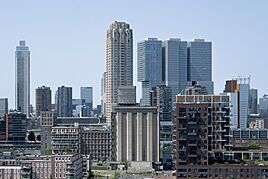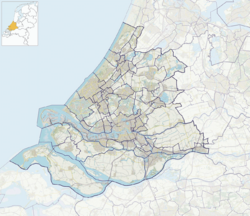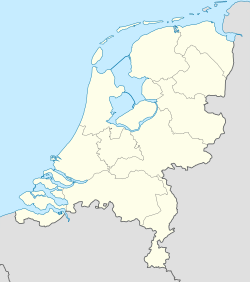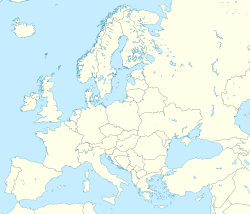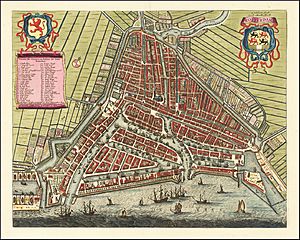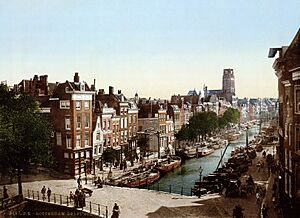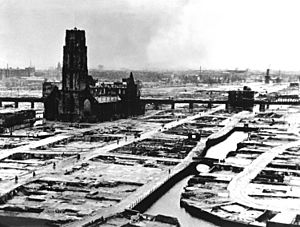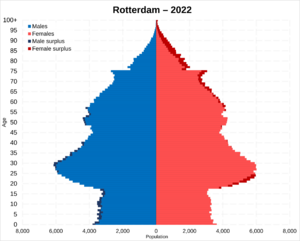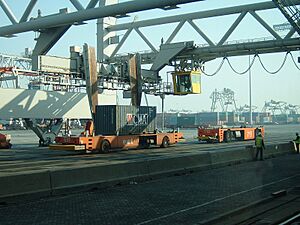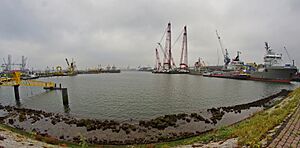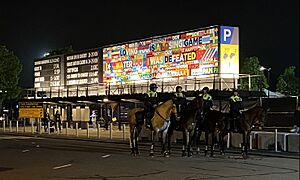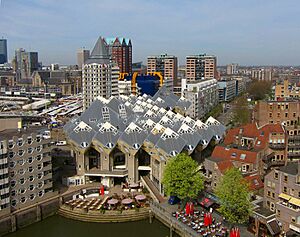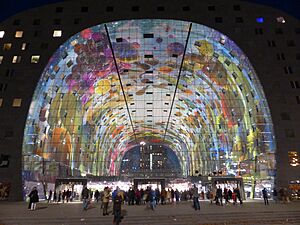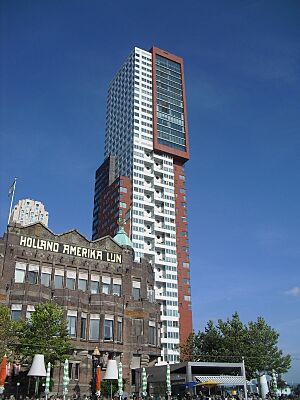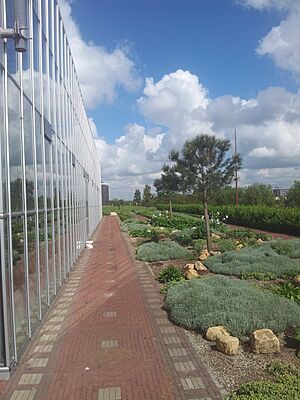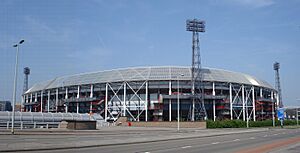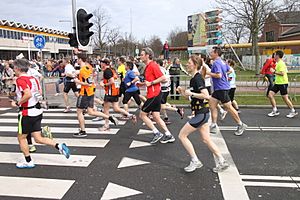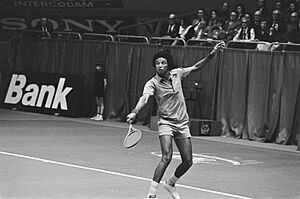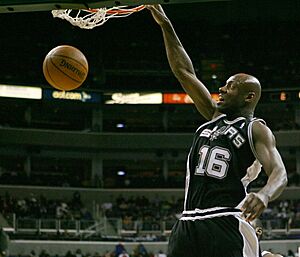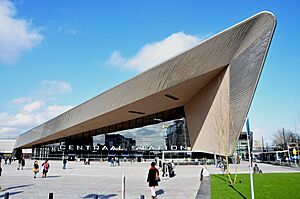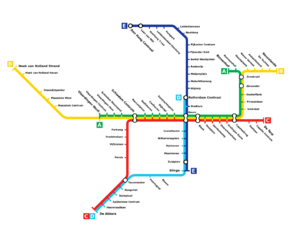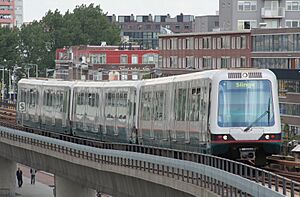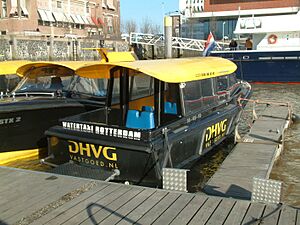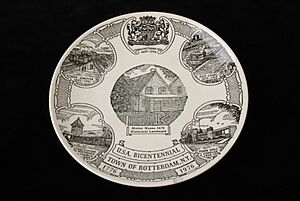Rotterdam facts for kids
Quick facts for kids
Rotterdam
|
|||||
|---|---|---|---|---|---|
|
City and municipality
|
|||||
|
Rotterdam skyline
Lawrence Church
The Destroyed City
Cube houses
De Kuip
Historic town centre of Delfshaven
Port of Rotterdam
|
|||||
|
|||||
| Nickname(s): | |||||
| Motto(s):
Sterker door strijd (Stronger through effort)
|
|||||
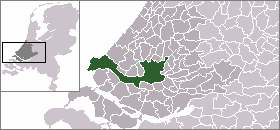
Location in South Holland
|
|||||
| Country | Netherlands | ||||
| Province | South Holland | ||||
| Districts |
Fourteen
Centrum
Charlois Delfshaven Feijenoord Hillegersberg-Schiebroek Hoogvliet Hook of Holland IJsselmonde Kralingen-Crooswijk Noord Overschie Pernis Prins Alexander Rozenburg |
||||
| Government | |||||
| • Body | Municipal council | ||||
| Area | |||||
| • Municipality | 325.79 km2 (125.79 sq mi) | ||||
| • Land | 208.80 km2 (80.62 sq mi) | ||||
| • Water | 116.99 km2 (45.17 sq mi) | ||||
| • Randstad | 3,043 km2 (1,175 sq mi) | ||||
| Population
(1 January 2023)
|
|||||
| • Municipality | 664,311 | ||||
| • Density | 2,969/km2 (7,690/sq mi) | ||||
| • Urban | 1,015,215 | ||||
| • Metro | 1,181,284 | ||||
| • Randstad | 8,366,078 | ||||
| Demonym(s) | Rotterdammer | ||||
| Time zone | UTC+1 (CET) | ||||
| • Summer (DST) | UTC+2 (CEST) | ||||
| Postcode |
3000–3099
|
||||
| Area code | 010 | ||||
| Click on the map for a fullscreen view | |||||
Rotterdam is a large and exciting city in the Netherlands. It is the second-largest city in the country, right after Amsterdam. Rotterdam is located in the province of South Holland, near where the Rhine and Meuse rivers meet the North Sea.
The city's story began in 1270 when a dam was built on the Rotte River. In 1340, Rotterdam officially became a city. Today, the Rotterdam–The Hague area is one of the biggest urban areas in Europe.
Rotterdam is a very important place for trade and business. It has Europe's largest seaport, which is like a huge gateway for goods coming into and leaving Europe. In 2022, over 655,000 people lived in Rotterdam, coming from more than 180 different countries!
The city is famous for its university, its location by the river, and its lively culture. It is also known for its amazing modern architecture. Much of the city center was destroyed during World War II, which led to many new and unique buildings being built.
The rivers Rhine, Meuse, and Scheldt connect Rotterdam to the heart of Western Europe. This, along with its great roads and railways, has earned Rotterdam the nicknames "Gateway to Europe" and "Gateway to the World."
Contents
History of Rotterdam
Rotterdam has a long and interesting past, from its early days as a small settlement to becoming a major world port.
Early Beginnings
The area where Rotterdam now stands was settled around the year 950. It was near a muddy river called the Rotte. Around 1150, big floods caused people to build protective walls called dikes and dams. One important dam was built on the Rotte River in the 1260s.
On July 7, 1340, Rotterdam was officially given city rights. At that time, only a few thousand people lived there. Around 1350, a shipping canal was finished. This canal helped Rotterdam connect with bigger towns to the north. It became an important place for trading goods between the Netherlands, England, and Germany.
Trade and Growth
Starting in the 1600s, Rotterdam played a role in the Atlantic slave trade. Merchants from Rotterdam were among the first in the Netherlands to be involved in this trade. Dutch ships from Rotterdam sailed to Africa and the Americas as part of a large trade network. This continued until 1814, when the Netherlands stopped its involvement in the slave trade.
The port of Rotterdam grew steadily over time. It became a key location for major trading companies like the Dutch East India Company and the Dutch West India Company.
A huge boost in growth happened after the Nieuwe Waterweg (a new waterway) was completed in 1872. The city and its harbor began to expand onto the south side of the river. The Witte Huis (White House) skyscraper, built in 1898, showed how fast Rotterdam was growing. It was the tallest office building in Europe when it was finished, standing 45 meters (148 feet) tall.
Rotterdam in the 20th Century
During World War I, the Netherlands remained neutral. Because of its location, Rotterdam became a major center for spies. Many secret agents from different countries operated there.
In World War II, the German army invaded the Netherlands in May 1940. On May 14, 1940, the heart of Rotterdam was almost completely destroyed by German bombs. About 80,000 people lost their homes, and 900 were killed. The City Hall was one of the few buildings that survived. The artist Ossip Zadkine created a famous statue called De Verwoeste Stad (The Destroyed City) to remember this event.
After the war, Rotterdam was rebuilt from the 1950s to the 1970s. Since much of the old city was gone, new, modern buildings and spaces could be created. In 1953, the Lijnbaan opened, which was Europe's first car-free shopping street. The Euromast tower was built in 1960 for a flower and garden exhibition called the Floriade.
From the 1980s onwards, Rotterdam focused on bold new architecture. The old harbor areas were transformed. New apartments, offices, and fun places made the city center more lively. In the 1990s, the Kop van Zuid area was built on the south bank of the river, becoming a new business hub. Rotterdam was named European City of the Year in 2015.
Geography of Rotterdam
Rotterdam is split into two parts by the Nieuwe Maas river. Several bridges and tunnels connect the northern and southern sides.
City Layout
The main city center is on the northern bank of the Nieuwe Maas. However, new buildings have extended the center to parts of southern Rotterdam, especially an area called Kop van Zuid. From its inner core, Rotterdam stretches all the way to the North Sea through a large harbor area.
Many parts of Rotterdam are actually below sea level, protected by dikes. For example, the Prins Alexander Polder in the northeast is 6 meters (20 feet) below sea level. The lowest point in the Netherlands is just east of Rotterdam.

The Rotte River no longer flows directly into the Nieuwe Maas. Its waters are now pumped through a pipe.
Rotterdam is part of a larger urban area called Rijnmond. It is also very close to The Hague. These two cities share an airport and a light rail system called RandstadRail. There are plans to create an official Metropolitan region Rotterdam The Hague, which would have about 2.5 million people.
This larger area is part of the Randstad, one of Europe's most important economic and populated regions. The Randstad has a population of 7.1 million people.
Climate and Weather
Rotterdam has a mild oceanic climate. This means its weather is influenced by the nearby coast. Winters are cool, and summers are mild to warm. Temperatures usually go above 30 °C (86 °F) about 4 days each summer. In winter, temperatures can drop below −5 °C (23 °F) for short times, especially with winds from the east.
Rainfall is moderate throughout the year. Spring and summer tend to be drier and sunnier. Autumn and winter are cloudier with more rain or snow. The city center can feel a bit warmer than the airport due to the "urban heat island" effect.
People of Rotterdam
Rotterdam is a very diverse city, with people from many different backgrounds living there.
Population and Districts
The city of Rotterdam is part of the larger Rotterdam–The Hague metropolitan area, which has about 2.5 million people. The city itself covers an area of 325.79 square kilometers (125.79 square miles). As of 2023, Rotterdam has a population of 664,311.
Rotterdam's population reached its highest point in 1965 with over 731,000 people. After that, some people moved to the suburbs, and the population went down. However, it has been growing again since the 1980s.
The city is divided into 14 smaller areas called submunicipalities. These include Centrum, Charlois, Delfshaven, and Prins Alexander, which is the largest with about 85,000 residents. Over the years, Rotterdam has grown by combining with several nearby towns and villages.
Diverse Backgrounds
Rotterdam has a very high percentage of residents whose parents were born outside the Netherlands. About 52.9% of the population has at least one parent born in another country. This makes Rotterdam a very multi-ethnic and multicultural city.
There are many different communities in Rotterdam. For example, it has a large Dutch Antillean community and its own Chinatown near Rotterdam Centraal station. The former mayor of Rotterdam, Ahmed Aboutaleb, who served until 2024, was of Moroccan descent and a practicing Muslim.
Religion in Rotterdam
Christianity is the largest religion in Rotterdam, with 36.3% of people identifying as Christian. Islam is the second-largest religion (13.1%), followed by Hinduism (3.3%). About half of the people in Rotterdam say they have no religious affiliation.
Rotterdam is home to the Catholic bishop of Rotterdam. Since 2010, the city has the largest mosque in the Netherlands, the Essalam Mosque, which can hold 1,500 people.
Economy and Business
Rotterdam is a major economic hub, especially because of its huge port.
Shipping and Companies
Rotterdam has always been a key center for the shipping industry in the Netherlands. The Dutch East India Company, one of the world's first big companies, had a branch in Rotterdam in 1602.
Today, many well-known companies have their headquarters in Rotterdam. These include asset management firm Robeco, energy company Eneco, and dredging company Van Oord. Other big companies like LyondellBasell (chemicals) and Pfizer (pharmaceuticals) have regional offices here.
The city also owns two important companies: Roteb, which handles sanitation and waste, and the Port of Rotterdam Authority, which manages the port.
Rotterdam's port is the largest in Europe. The Maas and Rhine rivers provide excellent access to inland areas of Western Europe. In 2004, Shanghai became the world's busiest container port, but Rotterdam remains a global leader. The port handles many different types of goods, especially petrochemicals and general cargo. Goods are transported from Rotterdam by ship, train, or road. A new fast freight railway, the Betuweroute, connecting Rotterdam to Germany, was completed in 2007.
Shopping and City Life
Rotterdam has many famous streets and shopping areas. The Lijnbaan, opened in 1953, was Europe's first car-free shopping street. The Coolsingel is another main street with the city hall. It was updated between 2018 and 2021 to give more space to cyclists and walkers.
The Koopgoot (Shopping Gutter) is a unique shopping area that goes below street level. For more upscale shopping, there's the Kruiskade, with stores like Michael Kors and Hugo Boss. The Markthal is a modern building with many small shops and food stalls, and it's also a famous architectural landmark.
Education in Rotterdam
Rotterdam has excellent schools and universities, attracting students from all over the world.
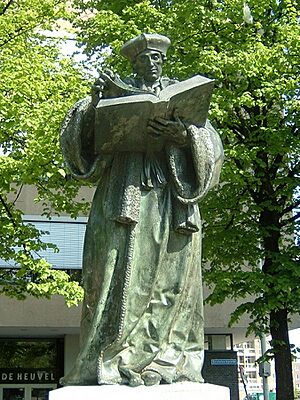
The main university is Erasmus University Rotterdam (EUR), named after the famous philosopher Desiderius Erasmus who lived in the city. Its business school, Rotterdam School of Management, Erasmus University, is highly ranked globally. The university is also home to very large student associations.
The Willem de Kooning Academy is Rotterdam's main art school. It is known as one of the best art schools in the Netherlands. The Piet Zwart Institute is part of this academy, offering advanced studies in art and design.
The Erasmus Medical Center, part of EUR, includes a general hospital, a children's hospital, and a cancer institute. It is ranked among the top hospitals and medical universities in Europe.
Rotterdam also has three Hogescholen (Universities of Applied Sciences). These schools offer practical degrees. They include Hogeschool Rotterdam, Hogeschool Inholland, and Codarts University for the Arts, which teaches music, dance, and circus.
A unique school in the city is the Shipping & Transport College. It offers many different programs related to shipping and transport.
Culture and Arts
Rotterdam has grown into a vibrant cultural city, offering many museums, events, and a lively nightlife.
Museums and Libraries
Rotterdam has many interesting museums. Some well-known ones are the Museum Boijmans Van Beuningen, Het Nieuwe Instituut, and the Maritime Museum Rotterdam. The Museum Rotterdam shows how Rotterdam has developed into a modern, international city.
Other museums include the Tax & Customs Museum and the Natural History Museum. The FENIX Museum of Migration is planned to open in 2025.
The first public library in Rotterdam was started in 1604. Today, the Bibliotheek Rotterdam is the largest cultural organization in the city, with 15 branches. The Rotterdam City Archives keeps historical records and documents about the city's past.
Music, Film, and Festivals
Rotterdam has a rich history in popular music, including a strong Jazz scene. A famous event was the Kralingen Music Festival in 1970, which featured big bands like Pink Floyd.
The city also became the home of Gabber, a type of fast electronic music popular in the 1990s. Today, Rotterdam has music venues like Rotown and Annabel. WORM focuses on experimental music and other cultural activities.
Rotterdam has a long film history. The International Film Festival Rotterdam (IFFR) is a major annual event held in late January and early February. Other film festivals, like the Architecture Film Festival Rotterdam (AFFR), also take place here.
Many different festivals happen in Rotterdam throughout the year. These include the Caribbean-inspired "Summer Carnival", the North Sea Jazz Festival (in July), and the World Port Days (in September).
Eurovision Song Contest
Rotterdam hosted the Eurovision Song Contest 2021. The city was originally chosen to host the 2020 contest, but it was canceled due to the COVID-19 pandemic. Rotterdam then hosted the event at Rotterdam Ahoy in May 2021. This was the first time Rotterdam hosted the contest and the first time the Netherlands hosted it since 1980.
City Rivalry
Rotterdam has a friendly rivalry with Amsterdam, which is often seen as the cultural capital of the Netherlands. This competition is most noticeable between the football fans of Feyenoord (Rotterdam) and Ajax (Amsterdam). There's a saying: "Money is earned in Rotterdam, distributed in The Hague and spent in Amsterdam."
Architecture of Rotterdam
Rotterdam is famous worldwide for its modern and innovative buildings. It is often called Manhattan at the Meuse because of its impressive skyline.
Architectural History
In 1898, the 45-meter (148-foot) tall White House (Witte Huis) was completed. It was the tallest office building in Europe at that time.
In the early 20th century, Rotterdam saw the construction of important modern buildings. Examples include the Van Nelle Factory (1929), a modern factory design, and Feyenoord's football stadium De Kuip (1936). The Van Nelle Factory became a UNESCO World Heritage Site in 2014.
After the city center was bombed in World War II, Rotterdam was rebuilt with ambitious new architecture. The Lijnbaan (1952) was a pioneering car-free shopping street. Other famous buildings include the Cube Houses (1984) designed by Piet Blom.
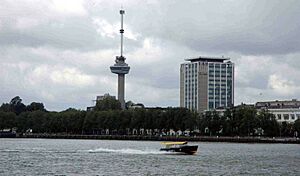
The newest landmark is the Markthal, designed by MVRDV. Rotterdam is also home to many internationally known architectural firms.
Tall Buildings and Bridges
Rotterdam has some of the tallest structures in the Netherlands.
- The Erasmusbrug (1996) is a 790-meter (2,600-foot) cable-stayed bridge. It connects the north and south parts of Rotterdam. Its unique shape has earned it the nickname 'De Zwaan' ('the Swan').
- The De Zalmhaven Tower, completed in 2021, is the tallest residential building in the Netherlands, standing 215 meters (705 feet) tall.
- The Maastoren is the tallest office building at 164.75 meters (540.5 feet). It became the tallest office tower in 2009.
- The Euromast is a 185-meter (607-foot) tall tower and a major tourist attraction. It was built in 1960 and extended in 1970.
Rotterdam is known as a place for architectural development and education. Over 30 new high-rise projects are being built or planned.
Parks and Green Spaces
Parks and green areas are important parts of Rotterdam's city design.
- Het Park is a large park near the Euromast. It was designed in the mid-1800s. The first Floriade (a flower exhibition) was held here in 1960.
- Museumpark, near Het Park, is surrounded by several museums.
- Diergaarde Blijdorp is a zoo in the northwest of Rotterdam, with a large sea aquarium called the Oceanium.
- Arboretum Trompenburg in Kralingen is a beautiful park with about 4,000 different types of trees and plants.
- The Kralingse Bos is a large forest with a lake, the Kralingse Plas. It officially opened in 1953.
- The Zuiderpark is a large park in the Charlois district.
Rotterdam encourages "Opzoomeren," where residents work together to improve their streets, often by creating small gardens. The city also promotes green roofs on buildings.
- The largest green roof in the city is on top of the Groothandelsgebouw near Central Station.
- The Dakakker is Europe's largest roof farm.
- The Dakpark is a long, narrow park built high up, about nine meters (30 feet) above ground.
Sports in Rotterdam
Rotterdam calls itself Sportstad (City of Sports) and hosts many famous sporting events.
Football
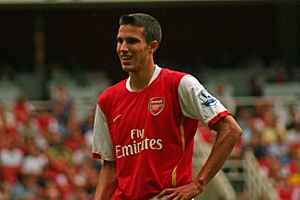
Rotterdam is home to three professional football clubs: Feyenoord, Sparta, and Excelsior.
Feyenoord, founded in 1908, is the most successful. It has won 16 national titles. Feyenoord was the first Dutch club to win the UEFA Champions League in 1970 and the World Cup for club teams in the same year. They also won the UEFA Cup in 1974 and 2002.
Feyenoord's stadium, Stadion Feijenoord, also known as De Kuip ('the Tub'), can hold 51,480 fans. It is the second-largest stadium in the Netherlands. De Kuip has hosted many international football games, including the final of UEFA Euro 2000.
Sparta, founded in 1888, has won the national title six times. Excelsior, founded in 1902, has not won any national titles.
Many great football players and coaches have come from Rotterdam, including Robin van Persie, Ruud Gullit, and Ronald Koeman.
Marathon
Rotterdam has its own annual international Rotterdam Marathon. It is known for being one of the fastest marathon courses in the world. From 1985 to 1998, new world records were set in Rotterdam.
The men's track record is held by Bashir Abdi, who ran it in 2:03.36 in 2021. The women's record was set in 2012 by Tiki Gelana, who later won the 2012 Olympic championship. The marathon starts and ends on the Coolsingel and attracts about 900,000 visitors.
Tennis
Since 1972, Rotterdam has hosted the ABN AMRO World Tennis Tournament. This indoor tennis event is part of the ATP Tour. Arthur Ashe won the first tournament in 1972 and holds the record for most singles titles.
Tour de France
Rotterdam hosted the start of the 2010 Tour de France in November 2008. The race began with a 7-kilometer (4.3-mile) individual time trial through the city center. The first regular stage left the Erasmusbrug and headed south.
The 2024 edition of the Tour de France Femmes also started in Rotterdam, with three stages in the Netherlands.
Other Sports
Rotterdam has a strong tradition in other sports too.
- The student rowing club Skadi had members who won a gold medal at the 1996 Summer Olympics in rowing.
- In field hockey, Rotterdam has the largest club in the Netherlands, HC Rotterdam.
- Neptunus Rotterdam is the most successful European baseball team.
- Rotterdam has a long boxing tradition, with famous boxers like Bep van Klaveren.
- In swimming, Rotterdam has produced Olympic champions like Marie Braun and Rie Mastenbroek.
- Many Olympic sailors have come from Rotterdam, training at the Kralingse Plas.
Yearly Events
Rotterdam hosts several annual events that are unique to the city.
- The Zomercarnaval (Summer Carnival) is the second-largest Caribbean carnival in Europe.
- The North Sea Jazz Festival is the largest Jazz festival in Europe.
- The World Port Days is a three-day event celebrating the Port of Rotterdam.
Other events include:
- January: Six Days of Rotterdam (Cycling), International Film Festival Rotterdam
- February: Rotterdam Open (Tennis), Art Rotterdam (Art fair)
- April–June: Rotterdam Marathon, Poetry International, Koningsdag Festival (April 27), CHIO Rotterdam (Horse show), Roparun
- July: North Sea Jazz Festival, Summer Carnival
- August: Pleinbioscoop (Open-air cinema), Dag van de Romantische Muziek (Romantic music festival), Rotterdam Rave Festival
- September: The World Port Days
- November/December: Sinterklaas (Last weekend before December 5), Boterletterwedstrijden (Sailing regatta)
Transportation in Rotterdam
Rotterdam has a great transportation system, including motorways, an airport, trains, metro, trams, and even water taxis.
Motorways
Several major motorways connect to Rotterdam. Four of them form a 'Ring' (ring road) around the city:
- A20 (Ring North): From Hook of Holland to Gouda.
- A16 (Ring East): From Rotterdam to Breda (and on to Antwerp and Paris).
- A15 (Ring South): From Europoort to Nijmegen.
- A4 (Ring West): From Rotterdam to The Hague (and on to Amsterdam).
Two other motorways also serve Rotterdam:
- A13: From The Hague to Delft and Rotterdam.
- A29: From Bergen op Zoom to Rotterdam.
Airport
Rotterdam The Hague Airport is the third-largest airport in the Netherlands. It is smaller than Schiphol Airport but has grown steadily. It is popular with business travelers because of its quick service.
Train Services
Rotterdam is well-connected by train, both nationally and internationally.
- There are direct international trains to Belgium and France via Thalys.
- International trains also go to the south of France and London via the Eurostar.
- Frequent trains connect Rotterdam to other Dutch cities like The Hague, Amsterdam, Utrecht, and Eindhoven.
- Rotterdam Centraal is the city's main station. Other stations include Rotterdam Alexander and Rotterdam Blaak.
Metro System
In 1968, Rotterdam was the first Dutch city to open a metro system. The metro network has 78.3 kilometers (48.7 miles) of tracks and 70 stations, making it the largest in the Benelux countries. There are five lines: Lines A, B, and C run east–west, and Lines D and E run north–south. Line E connects Rotterdam with The Hague.
Tram Network
The Rotterdam tramway network has 9 regular tram lines and 4 special lines. The total length is 93.4 kilometers (58.0 miles). Trams serve many parts of the city and nearby areas.
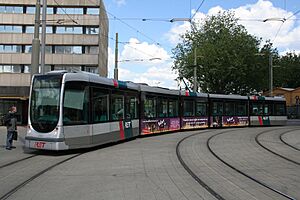
Bus Services
Rotterdam has 55 city bus lines, covering a total length of 432.7 kilometers (268.9 miles). The RET company runs buses within Rotterdam and to surrounding towns. Other companies also provide regional bus services.
Waterbus and Ferry
The Waterbus network has seven lines, with the main line stretching from Rotterdam to Dordrecht. These ferries carry passengers and bicycles. P&O Ferries also offers daily sailings from Europoort to Kingston upon Hull in the UK.
International Connections
Rotterdam has many connections with cities and ports around the world.
Twin Towns and Sister Cities
Rotterdam is twinned with several cities:
 Baltimore (since 1985)
Baltimore (since 1985) Burgas (since 1976)
Burgas (since 1976) Cologne (since 1958)
Cologne (since 1958) Constanța (since 1976)
Constanța (since 1976) Dresden (since 1988)
Dresden (since 1988) Esch-sur-Alzette (since 1958)
Esch-sur-Alzette (since 1958) Gdańsk (since 1977)
Gdańsk (since 1977) Havana (since 1983)
Havana (since 1983) Lille (since 1958)
Lille (since 1958) Liège (since 1958)
Liège (since 1958) Shanghai (since 1979)
Shanghai (since 1979) Saint Petersburg (since 1984)
Saint Petersburg (since 1984) Turin (since 1958)
Turin (since 1958) Şanlıurfa (since 2023)
Şanlıurfa (since 2023)
Partner Cities
Rotterdam also has partner city relationships:
 Antwerp (since 1940)
Antwerp (since 1940) Basel (since 1945)
Basel (since 1945) Bratislava (since 1991)
Bratislava (since 1991) Budapest (since 1991)
Budapest (since 1991) Duisburg (since 1950)
Duisburg (since 1950) Durban (since 1991)
Durban (since 1991) Hull (since 1936)
Hull (since 1936) Jakarta (since 1983)
Jakarta (since 1983) Nuremberg (since 1961)
Nuremberg (since 1961) Osaka Prefecture (since 1984)
Osaka Prefecture (since 1984) Oslo (since 1945)
Oslo (since 1945) Prague (since 1991)
Prague (since 1991)
Sister Ports
Places Named After Rotterdam
The town of Rotterdam in New York, USA, was founded in 1661 by Dutch settlers. They named it after the city in the Netherlands. This town uses the same motto as Rotterdam: Sterker door Strijd (Stronger through Effort).
Other places named after Rotterdam include:
 Nieuw Rotterdam, Nickerie District, Suriname (1866–1875)
Nieuw Rotterdam, Nickerie District, Suriname (1866–1875) Rotterdam, Limpopo, South Africa
Rotterdam, Limpopo, South Africa
Famous People from Rotterdam
Many notable people have come from Rotterdam, including philosophers, athletes, and artists.
- Pierre Bayle (1647–1706), a philosopher.
- Leo Beenhakker (born 1942), a football coach.
- Giovanni van Bronckhorst (born 1975), a former football player.
- Jules Deelder (1944–2019), a poet and writer.
- Desiderius Erasmus (1466–1536), a famous philosopher.
- Pim Fortuyn (1948–2002), a politician.
- Piet Pieterszoon Hein (1577–1629), a naval officer.
- Jacobus Henricus van 't Hoff (1852–1911), a chemist and Nobel Prize winner.
- Rem Koolhaas (born 1944), a world-famous architect.
- Willem de Kooning (1904–1997), a painter.
- Ruud Lubbers (1939–2018), a former Prime Minister of the Netherlands.
- Coen Moulijn (1937–2011), a football player.
- Robin van Persie (born 1983), a football player.
- Colonel Tom Parker (1909–1997), manager of Elvis Presley.
- Marten Toonder (1912–2005), a comic writer.
- Maarten Tromp (1598–1653) and Cornelis Tromp (1629–1691), Dutch admirals.
Images for kids
-
Van Nelle Factory, a UNESCO World Heritage Site since 2014.
See also
 In Spanish: Róterdam para niños
In Spanish: Róterdam para niños


